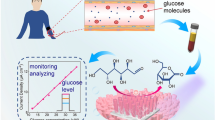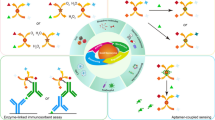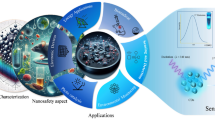Abstract
This study developed a non-enzymatic electrochemical sensor for measuring xanthine using CuO nanostructures made from sugar molasses. The influence of sugar molasses on the surface morphology, crystallization, and optical properties of CuO nanostructures have been investigated during low-temperature aqueous chemical growth method. The influence of different amounts of sugar molasses such as 1 mL (sample 1) and 2 mL (sample 2) on the shape, optical, and crystalline properties of CuO nanostructures was evaluated. The monoclinic phase of sugar molasses CuO nanostructures was confirmed and heterogeneity in the shape orientation was also observed. The optical characterization has revealed a decrease in the optical band gap from 3.36 eV, 2.90 eV, and 2.36 eV for the pure CuO, sample 1, and sample 2, respectively. The proposed CuO nanostructures were found highly active toward electrochemical non-enzymatic detection of xanthine in phosphate buffer solution of pH 7.0. The CuO nanostructures prepared with 1 mL of sugar molasses (sample 1) were observed highly efficient toward non-enzymatic xanthine detection and dynamic linear ranges for various xanthine concentrations were estimated using cyclic voltammetry (CV) and chronoamperometry (CA). Both CV and CA have revealed the dynamic linear range of proposed xanthine sensor from 0.0001 to 0.01 mM and a limit of detection (LOD) of 0.00001 mM. The presented xanthine sensor was evaluated by different sensor evaluation parameters such as selectivity, stability, reproducibility, and the observed performance of sensor was found highly satisfactory. The CuO nanostructures prepared with sugar molasses (sample 1) has shown improved performance due to its high number of active sites, its favorable morphology, its tunable optical band gap, and its fast charge transfer rate at the interface. The CuO nanostructures (sample 1) exhibited charge transfer resistance of 7.72 Ohms and electrochemical active surface area of 0.00202 µF cm−2. Significantly, CV experiments were conducted under real-life conditions to detect xanthine. Taken together, the combined findings of this work clearly emphasize that sugar molasses-derived CuO nanostructures provide enhanced electrocatalytic properties, thereby offering potential use in diverse biomedical, food, and energy storage-related applications.








Similar content being viewed by others
Data availability
The authors declare that the data supporting the findings of this study are available within the paper.
References
Food and Agriculture Organization of the United Nations, Sustainable Food and Agriculture. http://www.fao.org/sustainability/en/
Organisation for Economic Co-operation and Development, http://www.oecd.org/futures/35391719.pdf
United Nations Educational, Scientific and Cultural Organization, What is Sustainable Consumption? http://www.unesco.org/education/tlsf/mods/theme_b/mod09.html?panel=6#top
D.A. Kostić, D.S. Dimitrijević, G.S. Stojanović, I.R. Palić, A.S. Dordević, J.D. Ickovski, Xanthine oxidase: isolation, assays of activity, and inhibition. J. Chem. 1, 1–8 (2015)
Y. Zhuang, L. Sun, B. Li, Production of the angiotensin-I-converting enzyme (ACE)-inhibitory pep tide from hydrolysates of jellyfish (Rhopilema esculentum) collagen. Food Bioprocess Technol. 5, 1622–1629 (2012)
A.T. Lawal, S.B. Adeloju, Polypyrrole-based xanthine oxidase potentiometric biosensor for hypoxanthine. J. Appl. Sci. 8, 2599–2605 (2008)
H. Khajehsharif, E. Pourbasheer, Acid in real matrix by orthogonal signal correction–partial least squares. J. Iran. Chem. Soc. 8, 1113–1119 (2011)
M.S. Rashed, A.A. Saadallah, Z. Rahbeeni, W. Eyaid, M.Z. Seidahmed, S. Al-Shahwan, M.A.M. Salih, M.E. Osman, M. Al-Amoudi, L. Al-Ahaidib, M. Jacob, Determination of urinary S-sulphocysteine, xanthine, and hypoxanthine by liquid chromatography–electrospray tandem mass spectrometry. Biomed. Chromatogr. 12, 223–230 (2005)
N. Coopera, R. Khosravanb, C. Erdmanna, J. Fienea, J.W. Lee, Quantification of uric acid, xanthine and hypoxanthine in human serum by HPLC for pharmacodynamic studies. J. Chromatogr. B 837, 1–10 (2006)
G. Mu, F. Luan, L. Xu, F. Hu, H. Liu, Y. Gao, Determination of purines in soybean milk by capillary electrophoresis in comparison with high performance liquid chromatography. Anal. Methods 4, 3386–3391 (2012)
J. Hlavay, S.D. Haemmerli, G.G. Guilbault, Fibre-optic biosensor for hypoxanthine and xanthine basd on a chemiluminescence reaction. Biosens. Bioelectron. 9, 189–195 (1994)
Z. Lin, J. Sun, J. Chen, L. Guo, Y. Chen, G. Chen, Electrochemiluminescent biosensor for hypoxanthine based on the electrically heated carbon paste electrode modified with xanthine oxidase. Anal. Chem. 80, 2826–2831 (2008)
M.J. Shin, J.G. Kim, J.S. Shin, Amperometric cholesterol biosensor using layer-by-layer adsorption technique on polyaniline-coated polyester films. Int. J. Polym. Mater. Polym. Biomater. 62, 140–144 (2013)
A.L. Sharma, P. Kumar, A. Deep, Highly sensitive glucose sensing with multi-walled carbon nanotubes—polyaniline composite. Polym. Plast. Technol. Eng. 51, 1382–1387 (2012)
P. Kalimuthu, S.A. John, Simultaneous determination of ascorbic acid, dopamine, uric acid and xanthine using a nanostructured polymer film modified electrode. Talanta 80, 1686–1691 (2009)
X. Cai, K. Kalcher, C. Neuhold, Simultaneous determination of uric acid, xanthine `and hypoxanthine with an electrochemically pretreated carbon paste electrode. Fresenius J. Anal. Chem. 348, 660–665 (1994)
M. Kathiwala, A.O. Affum, J. Perry, A. Brajter-Toth, Direct measurements of xanthine in 2000-fold diluted xanthinuric urine with a nanoporous carbon fiber sensor. Analyst 133, 810–816 (2008)
J.M. Zen, Y.Y. Lai, H.H. Yang, S.A. Kumar, Multianalyte sensor for the simultaneous determination of hypoxanthine, xanthine and uric acid based on a preanodized nontronite-coated screen-printed electrode. Sen Actuators B. 84, 237–244 (2002)
Y. Wang, Simultaneous determination of uric acid, xanthine and hypoxanthine at poly (pyrocatechol violet)/functionalized multi-walled carbon nanotubes composite film modified electrode. Colloids Surf. B 88, 614–621 (2011)
M. Dervisevic, E. Dervisevic, E. Cevik, M. Senel, Novel electrochemical xanthine biosensor based on chitosanepolypyrroleegold nanoparticles hybrid bio-nanocomposite platform. J. Food Drug Anal. 25, 510–519 (2017)
X. Zhang, J.S. Luo, P.Y. Tang, J.R. Morante, J. Arbiol, C.L. Xu, Q.F. Li, J. Fransaer, Ultrasensitive binder-free glucose sensors based on the pyrolysis of in situ grown cu MOF. Sensor Actuat B-Chem. 254, 272–281 (2018)
N. Lavanya, S. Radhakrishnan, N. Sudhan, C. Sekar, S.G. Leonardi, C. Cannilla, G. Neri, Fabrication of folic acid sensor based on the Cu doped SnO2 nanoparticles modified glassy carbon electrode. Nanotechnology 25, 295501 (2014)
A.C. Anithaa, N. Lavanya, K. Asokan, C. Sekar, WO3 nanoparticles based direct electrochemical dopamine sensor in the presence of ascorbic acid. Electrochim. Acta 167, 294 (2015)
M. Baghayeri, A. Amiri, S. Farhadi, Development of non-enzymatic glucose sensor based on efficient loading Ag nanoparticles on functionalized carbon nanotubes. Sens. Actuators B Chem. 225, 354–362 (2016)
M. Baghayeri, H. Veisi, Fabrication of a facile electrochemical biosensor for hydrogen peroxide using efficient catalysis of hemoglobin on the porous Pd@Fe3O4-MWCNT nanocomposite. Biosens. Bioelectron. 74, 190–198 (2015)
K. Hayat, A. Munawar, A. Zulfiqar, M.H. Akhtar, H.B. Ahmad, Z. Shafiq, M. Akram, A.S. Saleemi, N. Akhtar, CuO hollow cubic caves wrapped with biogenic N-rich graphitic C for simultaneous monitoring of uric acid and xanthine. ACS Appl. Mater. Interfaces 42, 47320–47329 (2020)
D. Zhu, H.Y. Ma, H.J. Pang, L.C. Tan, J. Jiao, T. Chen, Facile fabrication of a non-enzymatic nanocomposite of heteropolyacids and CeO2@Pt alloy nanoparticles doped reduced graphene oxide and its application towards the simultaneous determination of xanthine and uric acid. Electrochim. Acta 266, 54–65 (2018)
H. Ibrahim, Y. Temerk, A novel electrochemical sensor based on B doped CeO2 nanocubes modified glassy carbon microspheres paste electrode for individual and simultaneous determination of xanthine and hypoxanthine. Sensor Actuat B-Chem. 232, 125–137 (2016)
M. Wang, Z.X. Zheng, J.J. Liu, C.M. Wang, Pt-Pd bimetallic nanoparticles decorated nanoporous graphene as a catalytic amplification platform for electrochemical detection of xanthine. Electroanal. 29, 1–10 (2017)
M. Dervisevic, E. Dervisevic, E. Cevik, M. Senel, Novel electrochemical xanthine biosensor based on chitosan-polypyrrole-gold nanoparticles hybrid bio-nanocomposite platform. J. Food Drug Anal. 25, 510–519 (2017)
X.J. Zhang, J.P. Dong, X.Z. Qian, C.J. Zhao, One-pot synthesis of an RGO/ZnO nanocomposite on zinc foil and its excellent performance for the nonenzymatic sensing of xanthine. Sensor Actuat B-Chem. 221, 528–536 (2015)
S.K. Meher, G.R. Rao, Archetypal sandwich-structured CuO for high performance non-enzymatic sensing of glucose. Nanoscale 5, 2089–2099 (2013)
X. Liu, P. Pan, Z. Zhang, F. Guo, Z. Yang, J. Wei, Z. Wei, Ordered self-assembly of screen-printed flower-like CuO and CuO/MWCNTs modified graphite electrodes and applications in non-enzymatic glucose sensor. J. Electroanal. Chem. 763, 37–44 (2016)
X. Ma, Q. Zhao, H. Wang, S. Ji, Controlled synthesis of CuO from needle to flower-like particle morphologies for highly sensitive glucose detection. Int. J. Electrochem. Sci. 12, 8217–8226 (2017)
Y. Zhang, Y. Liu, L. Su, Z. Zhang, D. Huo, C. Hou, Y. Lei, CuO nanowires based sensitive and selective non-enzymatic glucose detection. Sens. Actuators B Chem. 191, 86–93 (2014)
B. Zheng, G. Liu, A. Yao, Y. Xiao, J. Du, Y. Guo, D. Xiao, Q. Hu, M.M. Choi, A sensitive AgNPs/CuO nanofibers non-enzymatic glucose sensor based on electrospinning technology. Sens. Actuators B Chem. 195, 431–438 (2014)
T.S. Babu, T. Ramachandran, Development of highly sensitive non-enzymatic sensor for the selective determination of glucose and fabrication of a working model. Electrochim. Acta 55, 1612–1618 (2010)
C. Batchelor-McAuley, Y. Du, G.G. Wildgoose, R.G. Compton, The use of copper (II) oxide nanorod bundles for the non-enzymatic voltammetric sensing of carbohydrates and hydrogen peroxide. Sens. Actuators B Chem. 135, 230–235 (2008)
D. Volanti, D. Keyson, L. Cavalcante, A.Z. Simões, M. Joya, E. Longo, J.A. Varela, P. Pizani, A. Souza, Synthesis and characterization of CuO flower-nanostructure processing by a domestic hydrothermal microwave. J. Alloys Compd. 459, 537–542 (2008)
H. Sridevi, M.R. Bhat, P.S. Kumar, N.M. Kumar, R. Selvaraj, Structural characterization of cuboidal α-Fe2O3 nanoparticles synthesized by a facile approach. Appl. Nanosci. 13(8), 5605–5613 (2023)
S. Faisal, H. Jan, S.A. Shah, S. Shah, A. Khan, M.T. Akbar, M. Rizwan, F. Jan, N. Wajidullah, N. Akhtar, A. Khattak, A., Green synthesis of zinc oxide (ZnO) nanoparticles using aqueous fruit extracts of Myristica fragrans their characterizations and biological and environmental applications. ACS Omega 6, 9709–9722 (2021)
S. Faisal, N.S. Al-Radadi, H. Jan, S.A. Abdullah, Shah, S. Shah, M. Rizwan, Z. Afsheen, Z. Hussain, M.N. Uddin, M. Idrees, Curcuma longa mediated synthesis of copper oxide, nickel oxide and Cu-Ni bimetallic hybrid nanoparticles: characterization and evaluation for antimicrobial, anti-parasitic and cytotoxic potentials. Coatings 11, 849 (2021)
Z. Alhalili, Green synthesis of copper oxide nanoparticles CuO NPs from Eucalyptus Globulus leaf extract: adsorption and design of experiments. Arab. J. Chem. 15, 103739 (2022)
S.C. Mali, A. Dhaka, C.K. Githala, R. Trivedi, Green synthesis of copper nanoparticles using Celastrus paniculatus willd leaf extract and their photocatalytic and antifungal properties. Biotechnol. Rep. 27, e00518 (2020)
O.O. Abosede, G.K. Obiyenwa, Green synthesis of copper oxide nanoparticles using Justicia Carnea. Int. J. Chem. Stud. 10, 21–25 (2022)
G. Afzal, A. Jamal, S. Kiran, G. Mustafa, T. Mehmood, F. Ahmad, S. Saeed, A. Ali, N. Naz, S.S. Zehra, S. Khalil, Copper oxide nanoparticles synthesis using Aerva Javanica and their antimicrobial activities. J. Anim. Plant Sci. 32, 1403–1411 (2022)
P. Ni, Y. Sun, Y. Shi, H. Dai, J. Hu, Y. Wang, Z. Li, Facile fabrication of CuO nanowire modified Cu electrode for non-enzymatic glucose detection with enhanced sensitivity RSC Adv. 4, 28842 (2014)
J. Essic, R. Mather, Characterization of a bulk semiconductors band gap via near- absorption edge optical transmission experiment. Am. J. Phys. 61, 646–649 (1993)
A.A. Radhakrishnan, B.B. Beena, Structural and optical absorption analysis of CuO nanoparticles. Ind. J. Adv. Chem. Sci. 2, 158–161 (2014)
S. Gandhi, R.H.H. Subramani, T. Ramakrishnan, A. Sivabalan, V. Dhanalakshmi, M.R.G. Nair, R. Anbarasan, Ultrasound assisted one pot synthesis of nano-sized CuO and its nanocomposite with poly(vinyl alcohol). J. Mater. Sci. 45, 1688–1694 (2010)
Y. Xu, D. Chen, X. Jiao, K. Xue, CuO microflowers composed of nanosheets: synthesis, characterization and formation mechanism. Mater. Res. Bull. 42, 1723–1731 (2007)
B. Serapinienė, L. Gudavičiūtė, S. Tutlienė, A. Grigucevičienė, A. Selskis, J. Juodkazytė, R. Ramanauskas, On the electrochemically active surface area determination of electrodeposited porous Cu 3D nanostructures. Coatings 13, 1335 (2023)
M.A. Rahman, M.-S. Won, Y.-B. Shim, Xanthine sensors based on anodic and cathodic detection of enzymatically generated hydrogen peroxide. Electroanalysis 19, 631–637 (2007)
B. Dalkıran, P. E. Erden, E. Kılıç, Construction of an electrochemical xanthine biosensor based on graphene/ cobalt oxide nanoparticles/chitosan composite for fish freshness detection. J. Turk. Chem. Soc. Sect. A 4, 23–44 (2017)
D. Shan, Y. Wang, H. Xue, S. Cosnier, Sensitive and selective xanthine amperometric sensors based on calcium carbonate nanoparticles. Sens. Actuators B 136, 510–515 (2009)
R. Devi, M. Thakur, C. Pundir, Construction and application of an amperometric xanthine biosensor based on zinc oxide nanoparticles–polypyrrole composite film. Biosens. Bioelectron. 26, 3420–3426 (2011)
F. Zhang, Z. Wang, Y. Zhang, Z. Zheng, C. Wang, Y. Du, W. Ye, Simultaneous electrochemical determination of uric acid, xanthine and hypoxanthine based on poly(l-arginine)/graphene composite film modified electrode. Talanta 93, 320–325 (2012)
M. Dervisevic, E. Custiuc, E. Çevik, Z. Durmus, M. Şenel, A. Durmus, Electrochemical biosensor based on REGO/Fe3O4 bionanocomposite interface for xanthine detection in fish sample. Food Control 57, 402–410 (2015)
Acknowledgements
The authors wish to acknowledge the Pakistan Science Foundation (PSF) for partial support under the project PSF/CRP/Consrm-66. Authors acknowledge the Higher Education Commission Pakistan for its partial support of the project NRPU/8350. Ajman University-DRGS-2023-IRG-HBS-02 and the Researchers Supporting Project Number (RSP2023R78) at King Saud University, Riyadh, Saudi Arabia are also greatly acknowledged.
Funding
The authors have not disclosed any funding.
Author information
Authors and Affiliations
Contributions
BW analyzed jellyfish samples and provided information about jellyfish food. AT performed the XRD and FTIR analyses and wrote the first draft. SA contributed to the jellyfish sampling and provided the sources. AB synthesized the material and measured the FTIR spectrum. MAB presented the results and performed the optical studies. AS prepared the jellyfish meat samples and assisted in the actual analysis of the samples. IAM performed the partial electrochemical analysis. MP conducted the ECSA calculations. ED validated the results and contributed to the first draft of the manuscript. AAS performed the SEM measurements. MT proofread and edited the first draft of the manuscript. AN edited the manuscript and partially supervised the work. AA performed the EIS analysis and drafted the report. ZHI supervised the study and wrote the first draft of the manuscript.
Corresponding authors
Ethics declarations
Conflict of interest
Authors declare no competing interests in the resented research work.
Ethical approval
There were no human and animal studies involved in this study.
Additional information
Publisher's Note
Springer Nature remains neutral with regard to jurisdictional claims in published maps and institutional affiliations.
Rights and permissions
Springer Nature or its licensor (e.g. a society or other partner) holds exclusive rights to this article under a publishing agreement with the author(s) or other rightsholder(s); author self-archiving of the accepted manuscript version of this article is solely governed by the terms of such publishing agreement and applicable law.
About this article
Cite this article
Waryani, B., Tahira, A., Akhtar, S. et al. Utilizing CuO nanostructures derived from sugar molasses for the detection of xanthine. J Mater Sci: Mater Electron 35, 232 (2024). https://doi.org/10.1007/s10854-023-11908-3
Received:
Accepted:
Published:
DOI: https://doi.org/10.1007/s10854-023-11908-3




